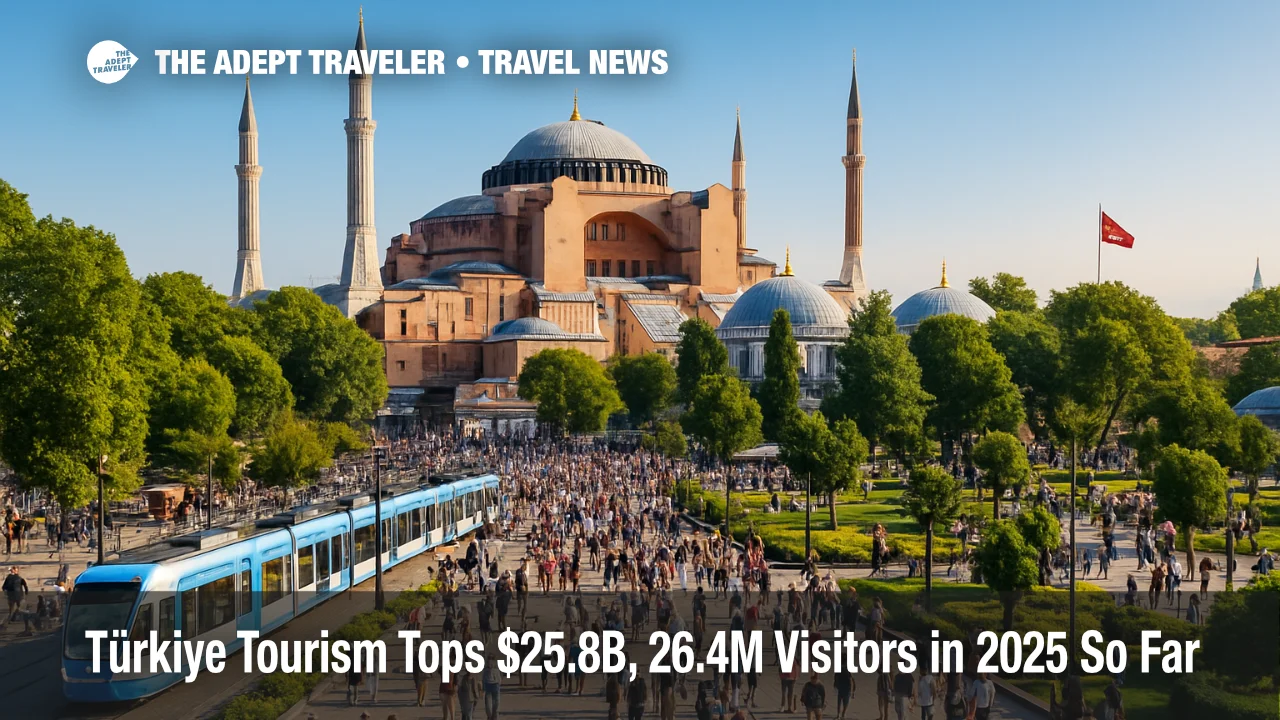Türkiye tourism tops $25.8B, 26.4M visitors in First Half of 2025

Türkiye's tourism engine kept humming through June, adding a record US $25.8 billion in revenue on 26.4 million international arrivals-proof that demand held firm despite regional turbulence. The Ministry's mid-year briefing in İstanbul showed per-night spending rising and only a marginal dip in average stay, positioning the sector to hit its US $64 billion year-end goal.
Key Points
- Why it matters: Record mid-year revenue signals robust traveler demand.
- Travel impact: Higher nightly spend-US $109-may lift prices for peak-season lodging.
- What's next: Ministry targets US $64 billion for 2025 and sharper market diversification.
- Double-digit visitor growth from Americas and Asia-Pacific offsets slower Europe.
Snapshot
From January 1 to June 30, 2025, Türkiye hosted 26.4 million foreign visitors, a 1 percent year-over-year rise. Tourism income climbed 7.6 percent to US $25.8 billion-the highest half-year haul on record-driven by an 8 percent bump in nightly spend to US $109. Travelers stayed an average 10.0 nights, just 0.9 percent shorter than last year. Russia led inbound markets with 2.61 million visitors, followed by Germany (2.42 million) and the United Kingdom (1.75 million).
Background
Tourism accounts for roughly 8 percent of Türkiye's GDP. After surpassing its pre-pandemic benchmark in 2024, the sector entered 2025 with momentum-even as conflicts in neighboring regions stoked uncertainty. Minister Mehmet Nuri Ersoy has emphasised moving from volume to value, expanding source markets beyond Europe and rolling out culture-rich regional itineraries to smooth seasonality. UN Tourism ranked Türkiye fourth worldwide for arrivals in 2024, adding weight to the government's diversification push.
Latest Developments
Spending resilience buoys revenue
Quarter-two tourism earnings hit US $16.28 billion, up 8.4 percent year-on-year, offsetting slower head-count growth. Analysts attribute the jump to higher average daily rates in coastal resorts and a currency environment that makes on-the-ground expenditures feel affordable to euro- and dollar-based travelers. Luxury operators also report a shift toward experiential add-ons such as private gulet charters and culinary masterclasses, which carry premium price tags. The ministry said ancillary spend now represents 32 percent of total receipts, compared with 28 percent pre-pandemic.
Minister doubles down on diversification
Speaking at İstanbul's Atatürk Cultural Center on July 31, Minister Ersoy highlighted double-digit visitor gains from the Americas, Central Asia and Asia-Pacific, underscoring "strategic focus on diversifying our destinations, products, and source markets." He pointed to Ireland-a smaller yet growing origin-as proof: arrivals reached 98,131 in six months, up 1 percent year-over-year. "In this difficult environment, we have continued to see growth in key metrics, particularly in our revenue," Ersoy noted, reaffirming the US $64 billion target for 2025.
Analysis
Türkiye's half-year data paint a picture of a market trading volume for value. A 1 percent uptick in arrivals would normally raise red flags, yet the 7.6 percent revenue increase suggests that higher-spending segments are filling the gap. The lira's prolonged weakness against the euro and dollar boosts purchasing power for foreign visitors, but it can also inflate operational costs for hoteliers importing goods. Longer-haul markets-from Mexico to South Korea-are answering the ministry's diversification call, reducing over-reliance on Russia and Germany. Still, geopolitical flashpoints in the Black Sea and Middle East pose downside risks. If currency volatility persists, suppliers may struggle to lock in pricing, which could erode the ADR-driven gains seen this spring. The government's pledge to elevate experiential offerings is timely; value-add products can cushion revenue should head counts falter. Achieving the US $64 billion target will hinge on sustaining high per-capita spend through the shoulder season and converting emerging markets into repeat visitors.
Final Thoughts
With record half-year revenue and solid gains in per-night spending, Türkiye looks on track to meet its ambitious full-year goal. Continued diversification-both geographically and by product-will be critical to keep the growth story intact, especially as macro-uncertainty lingers. Watch for how luxury and cultural itineraries evolve this autumn; their performance will reveal whether value can keep outpacing volume in Türkiye tourism.
